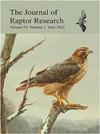Scavenging of Roadkill by Mississippi Kites (Ictinia mississippiensis)
IF 1.2
4区 生物学
Q2 ORNITHOLOGY
引用次数: 0
Abstract
Mississippi Kites (Ictinia mississippiensis) prey primarily on large-bodied aerial insects such as cicadas (Hemiptera), locusts (Orthoptera), dragon flies (Odonata), and beetles (Coleoptera) but will, occasionally, take small aerial and terrestrial vertebrate prey (Glinski and Ohmart 1983, Shaw 1985, Bader and Bednarz 2011, Chiavacci et al. 2014, Welch and Boal 2015). Mississippi Kites are aerial hunters, capturing their prey while in flight, but also glean prey from branches of trees and capture nestling birds from nests (Welch and Boal 2015, Parker 2020). Several species of Accipitriformes (e.g., Golden Eagles [Aquila chrysaetos], Ferruginous Hawks [Buteo regalis]) and Falconiformes (e.g., Merlins [Falco columbarius], Peregrine Falcons [F. peregrinus]) are known to engage in facultative scavenging (Knopper et al. 2006, McIntyre et al. 2009, Lonsdorf et al. 2018, Varland et al. 2018, Skalos et al. 2022). However, scavenging by Mississippi Kites has not been described; the only published reference to the behavior that I have found is the statement that they ‘‘Will scavenge diverse roadkills (JWP)’’ (Parker 2020). Here I reported two observations of scavenging by Mississippi Kites in the urban setting of Lubbock, TX, USA. On 7 July 2022 at 0940 H, I was in a vehicle on a residential two-lane street waiting to enter the flow of traffic on a north-south running six-lane (three lanes in each direction with a turn lane in the center) thoroughfare. I observed an adult Mississippi Kite flying up from the road as traffic came by. It circled and went back down low between lanes of south-bound traffic, flared up, circled again and went back down and landed on an apparently road-killed White-winged Dove (Zenaida asiatica). It appeared to try to peck at the dove before quickly taking flight again as a new wave of vehicles went by. I lost sight of the Mississippi Kite after that, but when I returned later in the day, the remains of the dove were still present. In a separate incident on 13 July 2022 at approximately 0830 H, I observed three adult Mississippi Kites making repeated swoops, one after the other, down to a road-killed bird while barely avoiding vehicle traffic on a busy residential street. The three birds landed only briefly on the dead bird and sometimes pecked at it. This continued for several minutes during which the kites swooped down then lifted up repeatedly, and sometimes circled around higher or perched on a tree in a yard before returning to swooping at the roadkill. They eventually gave up and drifted away from the area. I inspected the roadkill and found that it too was a White-winged Dove. White-winged Doves are not reported as prey of Mississippi Kites. However, the rich nutritional value and volume of an available White-winged Dove carcass, compared to the primarily invertebrate diet of kites, may be very attractive to a Mississippi Kite. The Mississippi Kites in these observations tried to feed on the carcasses where they lay rather than carrying them to a safer feeding location. This may be due to the mass of the doves exceeding what a kite can reasonably lift. Fully grown White-winged Doves weigh approximately 150 g or, depending on sex of the kite, 39– 70% of an adult kite’s mass (Parker 2020). This mass may prevent kites from removing road-killed doves to a safer location. Regardless, the kites I observed made repeated swoops and short landings at the roadkill and, thereby, subjected themselves to increased risk of a vehicle collision. Road-killed birds are not uncommon in urban settings and could provide abundant scavenging opportunities for Mississippi Kites. However, scavenging road-killed animals is a risky behavior that may result in death of the scavenging animal. For example, mortality of Golden Eagles from collision with vehicles while scavenging road-kills is a primary conservation concern (Lonsdorf et al. 2018, Slater et al. 2022), and Wildman et al. (1998) reported Red Kites (Milvus milvus) were killed by vehicle collisions while scavenging road-killed animals. Mississippi Kites typically forage at canopy heights and higher (Parker 2020) so vehicle collisions would not typically be an expected mortality risk for them. However, scavenging may be a 1 Email address: clint.boal@ttu.edu密西西比鸢(Ictinia密西西比)清除道路上的猎物
密西西比鸢(Ictinia Mississippi)主要捕食体型较大的空中昆虫,如蝉(半翅目)、蝗虫(直翅目)、蜻蜓(蜻蜓目)和甲虫(鞘翅目),但偶尔也会捕食小型空中和陆地脊椎动物(Glinski and Ohmart 1983, Shaw 1985, Bader and Bednarz 2011, Chiavacci et al. 2014, Welch and Boal 2015)。密西西比风筝是空中猎人,在飞行中捕捉猎物,但也从树枝上收集猎物,从巢穴中捕捉雏鸟(Welch和Boal 2015, Parker 2020)。一些鹰形目(如金鹰[Aquila chrysaetos],铁鹰[Buteo regalis])和隼形目(如隼[Falco columbarius],游隼[F.;peregrinus])参与兼性清除(Knopper et al. 2006, McIntyre et al. 2009, Lonsdorf et al. 2018, Varland et al. 2018, Skalos et al. 2022)。然而,密西西比鸢的食腐没有被描述;我发现的关于这种行为的唯一发表的参考文献是它们“会清除各种道路死亡(JWP)”(Parker 2020)的声明。在这里,我报告了密西西比风筝在美国德克萨斯州拉伯克市的城市环境中拾荒的两次观察。2022年7月7日上午9点40分,我在一条住宅双车道街道上的一辆车里,等待进入一条南北走向的六车道(每个方向有三条车道,中间有一条转弯车道)的交通流。当车辆经过时,我看到一只成年的密西西比风筝从路上飞了起来。它盘旋了一圈,又在南行的车道之间低空飞了回来,突然爆发,又盘旋了一圈,又飞了回去,落在一只显然被公路撞死的白翅鸽子(Zenaida asiatica)身上。当一波又一波的车辆经过时,它似乎试图啄食鸽子,然后又迅速飞走了。在那之后,我就看不见密西西比风筝了,但是当我那天晚些时候回来的时候,鸽子的遗体还在。在2022年7月13日上午8点30分左右的另一起事件中,我观察到三只成年密西西比风筝一个接一个地反复俯冲,直到一只被道路撞死的鸟,而在繁忙的住宅街道上,它们几乎没有避开车辆。三只鸟只是短暂地落在那只死鸟身上,有时还啄啄它。这种情况持续了几分钟,在此期间,风筝俯冲下来,然后反复升起,有时在更高的地方盘旋,或者停在院子里的树上,然后再俯冲向路上的猎物。他们最终放弃了,漂离了这个地区。我检查了路上的尸体,发现它也是一只白翅鸽子。白翅鸽没有被报道为密西西比鸢的猎物。然而,与主要以无脊椎动物为食的风筝相比,白翼鸽子尸体丰富的营养价值和体积可能对密西西比风筝非常有吸引力。在这些观察中,密西西比鸢试图以它们躺在那里的尸体为食,而不是把它们带到一个更安全的喂食地点。这可能是由于鸽子的质量超过了风筝所能承受的重量。成年白翅鸽子的体重约为150克,根据风筝的性别,约为成年风筝重量的39 - 70% (Parker 2020)。这一团可能会阻止风筝把被道路撞死的鸽子转移到一个更安全的地方。无论如何,我观察到的风筝反复俯冲和短暂降落在路上的猎物上,因此,使自己受到车辆碰撞的风险增加。在城市环境中,被道路撞死的鸟类并不罕见,这可以为密西西比风筝提供充足的食腐机会。然而,食腐动物是一种危险的行为,可能会导致食腐动物死亡。例如,金鹰在清理道路上被杀死的动物时与车辆相撞而死亡是一个主要的保护问题(Lonsdorf等人,2018年,Slater等人,2022年),Wildman等人(1998年)报告说,红鸢(Milvus Milvus)在清理道路上被杀死的动物时因车辆碰撞而死亡。密西西比风筝通常在树冠高度或更高的地方觅食(Parker 2020),因此车辆碰撞通常不会成为它们预期的死亡风险。然而,清除可能是一个1电子邮件地址:clint.boal@ttu.edu
本文章由计算机程序翻译,如有差异,请以英文原文为准。
求助全文
约1分钟内获得全文
求助全文
来源期刊

Journal of Raptor Research
生物-鸟类学
CiteScore
2.30
自引率
17.60%
发文量
61
审稿时长
>12 weeks
期刊介绍:
The Journal of Raptor Research (JRR) is an international scientific journal dedicated entirely to the dissemination of information about birds of prey. Established in 1967, JRR has published peer-reviewed research on raptor ecology, behavior, life history, conservation, and techniques. JRR is available quarterly to members in electronic and paper format.
 求助内容:
求助内容: 应助结果提醒方式:
应助结果提醒方式:


